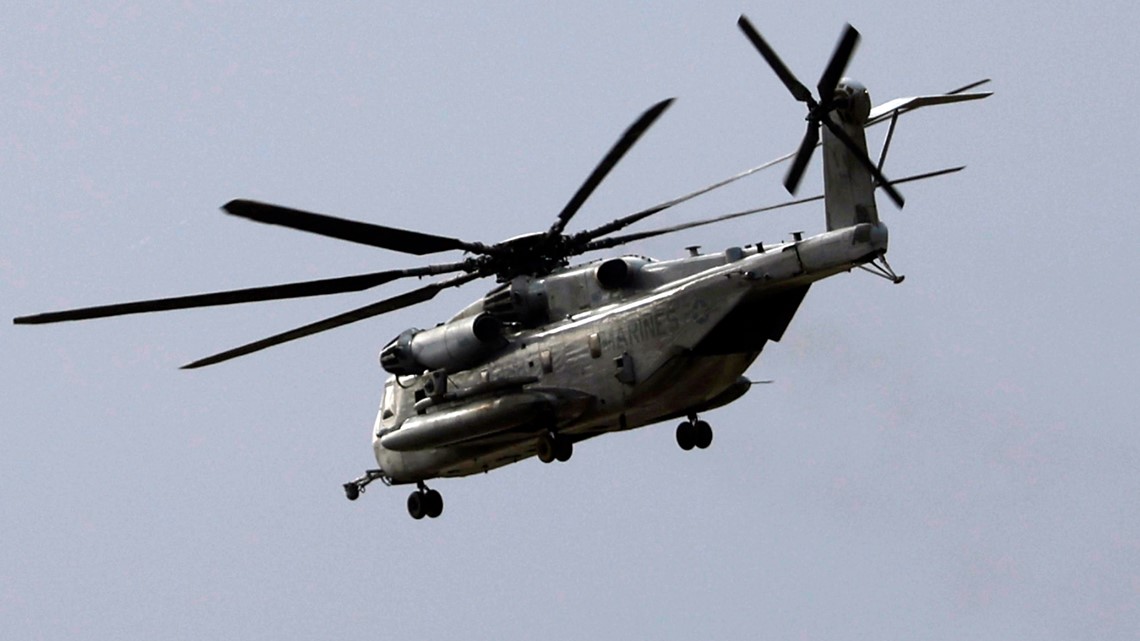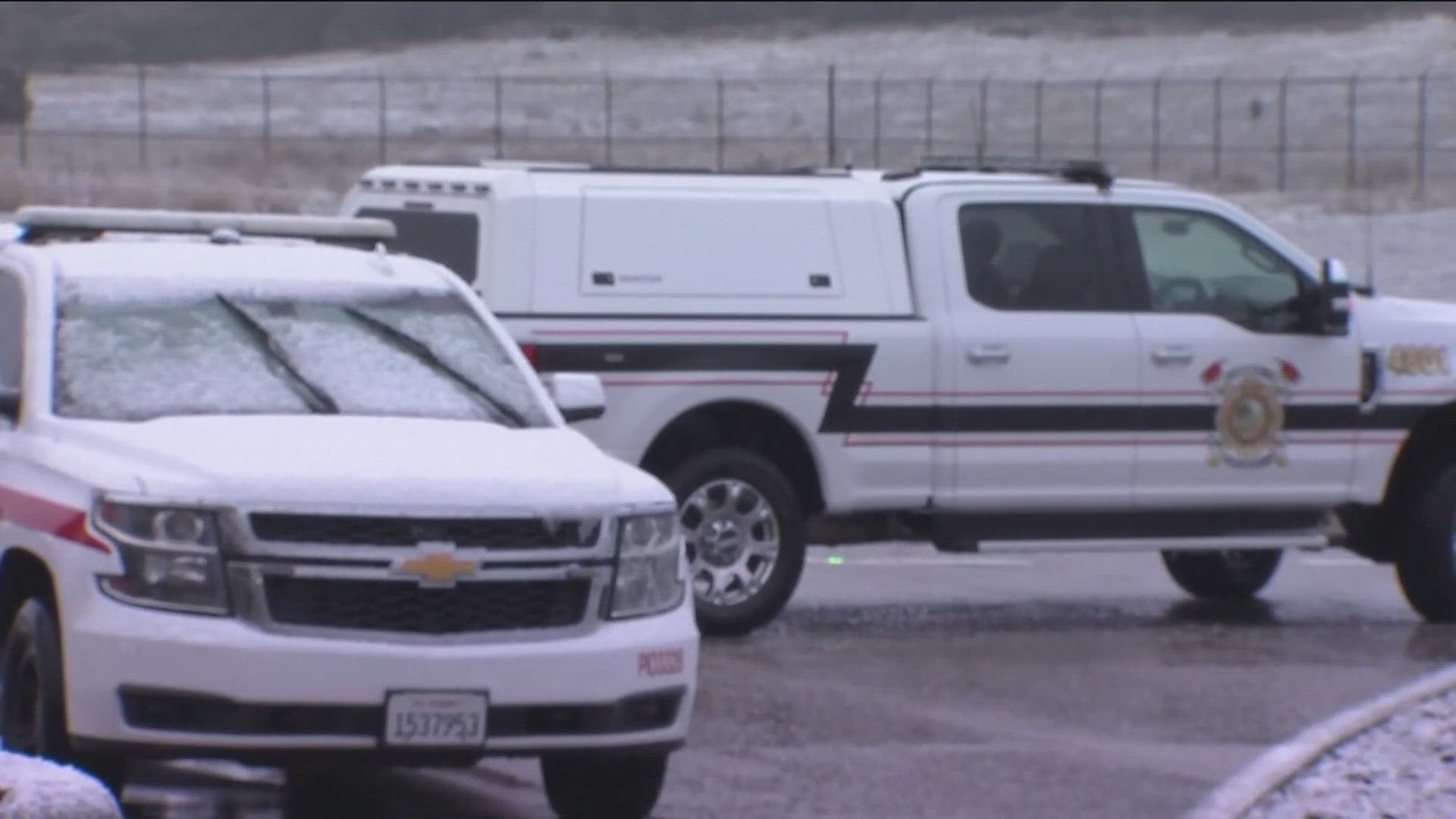SAN DIEGO — The helicopter carrying five Marines that crashed during stormy weather in the mountains outside San Diego was a CH-53E Super Stallion designed to fly through bad weather, even at night.
The Super Stallion is the largest helicopter in the military, but every aircraft has its limits, and while every flight for Marines is considered a training opportunity, there is inherent risk, experts say. Now investigators will be looking at whether it was appropriate to send troops into a region being clobbered by a storm of historic proportions.
The military confirmed Thursday that all five Marines were killed when their helicopter went down during stormy weather, and efforts were underway to recover their remains.
Marine Corps leaders, Defense Secretary Lloyd Austin and President Joe Biden expressed their condolences.
“It is with a heavy heart and profound sadness that I share the loss of five outstanding Marines from 3d Marine Aircraft Wing and the ‘Flying Tigers,’” Maj. Gen. Michael J. Borgschulte, commander of the wing, said in a statement.
Authorities say the CH-53E Super Stallion vanished late Tuesday night while conducting a flight training on their way back to Marine Corps Air Station Miramar in San Diego from Creech Air Force Base, northwest of Las Vegas.
The last known contact with the Super Stallion was at about 11:30 p.m. Tuesday, when waves of downpours and snow were hitting the region, Mike Cornette of the California Department of Forestry and Fire Protection told CBS 8 news. That location was based on a “ping” reported to a Cal Fire dispatch center.


Marines fly the model in the “most challenging environments you can think of,” said Timothy Loranger, a former Marine Corps aircraft mechanic and now civilian pilot and lawyer who specializes in aviation crashes.
“But even knowing that, it’s important for those making the decisions to decide whether the risk is worth it,” he said. “Here was a training mission with the crew flying back home to Miramar, so you have to ask, why fly in this weather now? Was this poor judgement or some pilot error issue? These are very important questions that have to be asked.”
A mechanical issue in bad weather would also make flying even harder. And while the helicopter was designed for bad weather, ice accumulation on rotor blades could disrupt the ability to create lift for the craft and cause it to crash, Loranger said.
All this will be part of the investigation, Loranger said, adding that it’s too early to speculate on what occurred. He said the Super Stallion has a long history of being reliable, but it’s not perfect.
The craft was discovered Wednesday morning near Pine Valley, an hour’s drive from San Diego.
The mountain community is at about 3,700 feet (1,127 meters) in elevation in the Cuyamaca Mountains, an area which saw as much 8 inches (20 centimeters) of accumulating snow within hours Tuesday night and early Wednesday and saw more falling Wednesday night, forecasters said.
The area includes San Diego County’s second highest mountain, Cuyamaca Peak, at 6,512 feet (1,985 meters), and is also near the Cleveland National Forest, which covers 720 square miles (1,860 square kilometers) with much of it steep, rocky and with limited trails.
Per military policy, the names of the Marines are not released until 24 hours after all next-of-kin have been notified. The five Marines were assigned to Miramar’s Marine Heavy Helicopter Squadron 361, Marine Aircraft Group 16, 3rd Marine Aircraft Wing at Miramar.
Capt. Stephanie Leguizamon, spokesperson for the wing, said she had little information beyond the statement but noted that recovery efforts were being hampered by snowfall from the storm that was moving out of California on Thursday.
“I do know that it's cold ... I know that's been a contentious issue” for searchers in reaching the crash site, she said.
Measuring about 99 feet (30 meters) long and weighing up to nearly 35 tons (31,638 kilograms), the CH-53E Super Stallion has been used in combat and other operations around the world for more than three decades, including in Beirut, Somalia, the Persian Gulf, Afghanistan, Iraq and Libya, according to a U.S. Navy website.
In 2018, four Marines from Miramar died when their Super Stallion crashed near El Centro, near the California-Mexico border, during a training mission. The Marine Corps ruled out pilot error for the accident. The victims’ families later sued two companies they alleged provided a defective part that they blamed for the crash.
In 2005, a Super Stallion went down in a sandstorm in Iraq, killing 31 people on board. The accident, blamed on pilot error, was the single deadliest loss of U.S. troops during the war.
More than 130 are in operation.
Nicknamed the “hurricane maker” because of the downwash from its three engines, the Super Stallion has a range of about 640 miles (1,029 kilometers). It was designed to carry up to 55 troops or about 16 tons (more than 13,000 kilograms) of cargo.
___
Baldor reported from Washington. Associated Press writers Ken Miller in Edmond, Okla. and John Antczak in Los Angeles contributed to this report.

